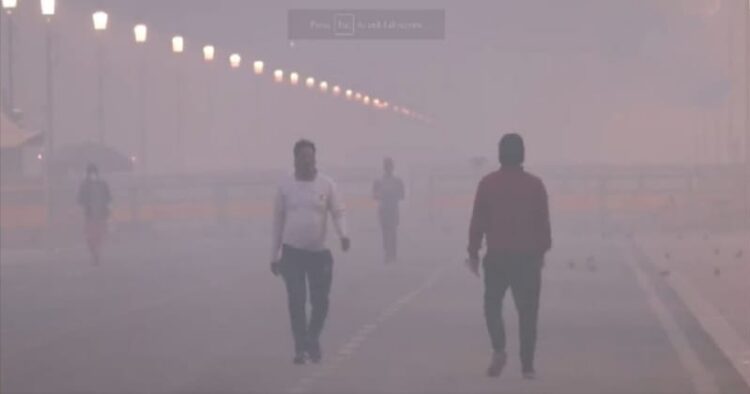A thick layer of smog veiled the national capital on November 15 morning, and the air quality was recorded in the ‘severe’ category in several parts of Delhi.
#WATCH | A layer of haze covers Delhi as the air quality in several areas in the city remains in 'Severe' category.
(Drone visuals from the area around AIIMS, shot at 7.10 am) pic.twitter.com/xsbnPzWzue
— ANI (@ANI) November 15, 2023
As per the Central Pollution Control Board (CPCB), the air quality in RK Puram was recorded at 420, 408 at New Moti Bagh, 404 at the IGI Airport area and 433 at Nehru Nagar, all in the severe category.
Visuals from India Gate and Lodhi Road area this morning showed people working out and carrying on with their daily chores amid a layer of haze in the city.
#WATCH | Delhi | Visuals from India Gate and Lodhi Road area as people work out and carry on with their daily chores amid a layer of haze in the air in the city.
(Visuals shot at 6.30 am today) pic.twitter.com/czhLcvJKk9
— ANI (@ANI) November 15, 2023
The city was engulfed in a thick layer of smog on the night of Deepawali and the toxic haze continued the next day following the bursting of firecrackers, despite the Supreme Court order.
Nine out of 11 State capitals analysed in India recorded higher pollution in the first 12 hours after Deepawali celebrations this year as compared to last year.
The Government’s National Clean Air Programme (NCAP) tracker analysed PM 2.5 (fine particulate matter) data for 11 capital cities.
Air quality across Delhi continues to be in the 'Severe' category as per the Central Pollution Control Board (CPCB).
AQI in Anand Vihar at 430, in RK Puram at 417, in Punjabi Bagh at 423, and in Jahangirpuri at 428 pic.twitter.com/8rexxurdAb
— ANI (@ANI) November 15, 2023
The highest spike (recorded at 15-minute intervals) was seen in the national capital, Delhi. It was at 999.5 ug/m3 at Pusa on November 13 at 1:30 am.
The NCAP Tracker is a joint project by Climate Trends and Respirer Living Sciences to create an online hub for the latest updates on India’s clean air policy, the National Clean Air Programme.
The data was sourced from the Continuous Ambient Air Quality Monitoring Stations (CAAQMS) of the Central Pollution Control Board.
Firecrackers were burst in the national capital and other cities on Deepawali despite alarming pollution levels and the Supreme Court’s ban on bursting crackers.
Meanwhile, Delhi Labour Minister Raaj Kumar Anand took stock of the implementation of measures to control air pollution at the Jonti Border area and reviewed the ground situation there. The minister also took stock of the implementation of the pollution control measures in the Kanjhawala area.
“Pollution in Delhi has been on the rise after Deepawali. We have to reduce the pollution level in Delhi and our Government is continuously working for it. We have been asking the locals to cooperate,” Raaj Kumar Anand told ANI after the inspection in the Kanjhawala area.
The pollution control measures under stage four of the GRAP are currently underway in the national capital. It will continue until further orders, said Delhi Environment Minister Gopal Rai on November 13.
(with inputs from ANI)




















Comments